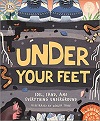|
Under Your Feet... Soil, Sand and Everything Underground

Last updated Wednesday, July 21, 2021
Author: Royal Horticultural Society
Illustrator: Wenjia Tang
Date of Publication: 2020
ISBN: 1465490957
Grade Level: 2nd (GLCs: Click here for grade level guidelines.)
Date(s) Used: Jul. 2021
Synopsis:
Down where worms wriggle and microbes squirm, there's a whole world waiting to be discovered...
Under Your Feet delves beneath the Earth's surface and explores the diverse wonders hidden there. Encounter creatures of the deep and marvel at the mind-boggling size of the humongous fungus - the biggest organism in the world. Learn how one handful of ordinary soil contains more organisms than there are people on Earth, and carry out experiments using dirt from your own back garden.
| Note to readers: |
| • |
Table of Contents is on p. 3
|
| • |
Each page is an infographic that goes over one topic. Readers can pre-select some topics to review with the students or readers can have the students each pick a topic to go over.
|
| • |
Glossary is on p. 32
|
| • |
Index is on p. 33
|
| Discussion topics for before reading: |
| • |
What are some of the insects and/or living organisms you see on the cover?
|
| • |
Can you count the number of layers under the soil?
|
| • |
What do you think is under your feet?
Vocabulary
|
| • |
Filtering – pass (a liquid, gas, light, or sound) through a device to remove
|
| • |
Absorbs – unwanted material.
|
| • |
Squashed – flat, soft or out of shape as a result of being crushed or squeezed with force.
|
| • |
Greenhouse gas – a gas that contributes to the greenhouse effect by absorbing infrared radiation.
|
| • |
Decaying – rotting or decomposing through the action of bacteria and fungi.
|
| • |
Tendrils – a slender threadlike appendage of a climbing plant, often growing in a spiral form, that stretches out and twines around any suitable support
|
| • |
Fibrous – consisting of or characterized by fibers.
|
| • |
Taproots – a straight tapering root growing vertically downward and forming the center from which subsidiary rootlets spring.
|
| Discussion topics for during/after reading: |
| • |
Have you played or planted a flower or vegetable in soil before?
|
| • |
Have you seen a worm before? Do you notice worms more after the rain?
|
| • |
Have you composted before? What items can you put into compost?
|
| • |
What are some ways you think you can help reduce your carbon footprint?
|
*Note: These craft ideas are just suggestions.
You can use them, but you don't have to use them.
You can expand upon them, or add your own twist.
Remember, though, that the focus of your time should
not be on the development and execution of a craft;
the focus should be on the read-aloud and the
enjoyment of the book!
|
